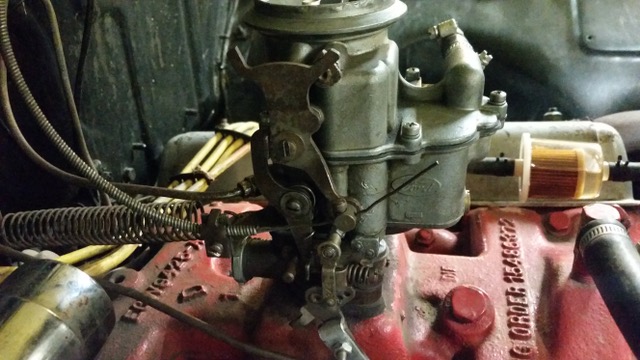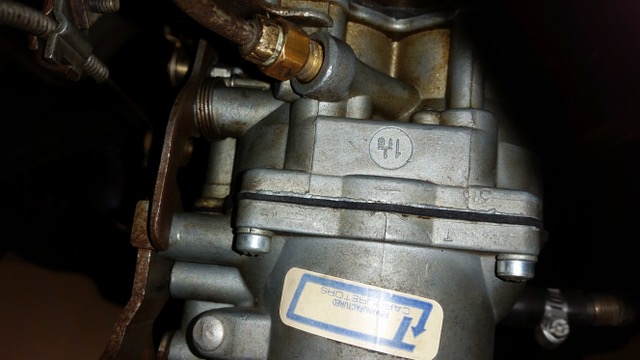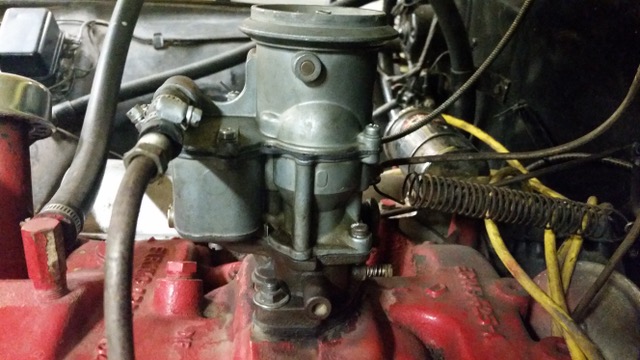|
Author
|
Message
|
|
Tedlauri
|
 Posted 4 Years Ago
Posted 4 Years Ago
|
|
Group: Forum Members
Last Active: Last Month
Posts: 40,
Visits: 11.3K
|
I always assumed ported vacuum was venturi vacuum, but now I have heard they are different. I do know what manifold vacuum is. I have a 1956 f100 272 with a 1957 distributor and the vacuum advance is hooked to the port at the back of the 2 barrel carb above the throttle so the vacuum advance gets no vacuum at idle but does get vacuum as I open the throttle. Do I have it hooked up correctly?   1956 F100 272 4 speed
1956 F100 272 4 speed
Northern California
|
|
|
|
|
Ted
|
|
|
Group: Administrators
Last Active: 6 days ago
Posts: 7.5K,
Visits: 205.8K
|
The ’56 and earlier carbs incorporate both venturi and ported vacuum attributes at that port you are using. The spark control valve below that port helps to differentiate between the two when using a Load-O-Matic distributor. When going with the ’57 and newer distributors, it is recommended to run ported vacuum only to the distributor. Here’s the link to the article that was published in The Y-Block Magazine that goes into detail on how to convert your particular carburetor so it’s compatible with the ’57 and newer distributors. https://www.eatonbalancing.com/2010/02/07/modifying-the-holley-94-two-barrel-for-late-model-distributors/
  Lorena, Texas (South of Waco) Lorena, Texas (South of Waco)
|
|
|
|
|
Tedlauri
|
|
|
Group: Forum Members
Last Active: Last Month
Posts: 40,
Visits: 11.3K
|
ok thank you, can you tell from my picture what the year and model of this carburetor is?
1956 F100 272 4 speed
Northern California
|
|
|
|
|
Daniel Jessup
|
|
|
Group: Forum Members
Last Active: 2 days ago
Posts: 2.0K,
Visits: 130.9K
|
From the 1 and 1/16 bore size, to the butterfly linkage, to the air horn, it looks to me like you have a 1955/56 F100 carburetor that were common to the 239's and 272's. Your air horn is specifically for a truck air cleaner. I "think" that all light trucks with the 2 barrel carb in both 55 and 56 would have had a manual choke carb (which the ECG 5 certainly is). The ECG 6 would be the automatic choke 2 barrel that was a one year only on passenger cars. The carburetor looks to be an ECG 5... if memory serves, the absence of a ball style linkage would point to a post flathead carburetor and we all know that the last year for flatheads was 1953. Not sure if your carb would be a 54 model... that could be. What letters/numbers are not the drivers side of the fuel bowl? Maybe some other guys will chime in here and correct me.  Daniel Jessup
Daniel JessupLancaster, California aka "The Hot Rod Reverend" 
check out the 1955 Ford Fairlane build at www.hotrodreverend.com
|
|
|
|
|
Tedlauri
|
|
|
Group: Forum Members
Last Active: Last Month
Posts: 40,
Visits: 11.3K
|
No numbers that I can see  1956 F100 272 4 speed
1956 F100 272 4 speed
Northern California
|
|
|
|
|
Tedlauri
|
|
|
Group: Forum Members
Last Active: Last Month
Posts: 40,
Visits: 11.3K
|
I drove around with a vacuum gauge hooked up to the threaded port up high on the back of the carburetor which I believed to be venturi vacuum but it acted like how I understand ported vacuum should work. At idle it was down to zero, cruising at around 2000 rpm it was about 15 on the gauge and when I hit the gas it drops. The more I step on it the more it drops
1956 F100 272 4 speed
Northern California
|
|
|
|
|
KULTULZ
|
|
|
Group: Forum Members
Last Active: Yesterday
Posts: 1.8K,
Visits: 306.3K
|
I drove around with a vacuum gauge hooked up to the threaded port up high on the back of the carburetor which I believed to be venturi vacuum but it acted like how I understand ported vacuum should work. At idle it was down to zero, cruising at around 2000 rpm it was about 15 on the gauge and when I hit the gas it drops. The more I step on it the more it drops
Possibly the CARB modification has already been performed if getting true ported vacuum signal and the engine has a 57/ DIST?
And then again, maybe not -
When using these carbs with the later model distributor which incorporates both a centrifugal and vacuum advance system, hooking up the vacuum advance without any carb modifications will provide an excess of vacuum signal to the distributor’s vacuum advance chamber at both idle and full throttle. This in turn creates tuning and drivabilty issues as well as increasing the propensity for detonation. Here is a pictorial in which to convert the Holley 94’s and 2100’s so that only a ported vacuum signal is supplied to the distributor and in turn makes this older model carburetor function similar to the ’57 and up carbs in both performance and fuel economy.
____________________________
|
|
|
|
|
Tedlauri
|
|
|
Group: Forum Members
Last Active: Last Month
Posts: 40,
Visits: 11.3K
|
Yes the distributor does have weights and springs so at least 1957 and there is no vacuum at idle and almost no vacuum at full throttle. Cruising at 2000 rpm the gauge says between 15 and 20 inches of vacuum
1956 F100 272 4 speed
Northern California
|
|
|
|
|
Tedster
|
|
|
Group: Forum Members
Last Active: 3 Years Ago
Posts: 513,
Visits: 153.3K
|
15" or better at cruise is pretty typical I expect. The more, the better for street driven engines basically. Can learn a lot from watching a vacuum gauge driving around under various conditions. We always read about how the engine vacuum goes away when accelerating. Well, it comes right back too, and in just a split second! All I can say, is that distributor advance plate must get a real workout, and earns its keep.
What kind of vacuum advance mechanism does your distributor have? Early to mid Ford distributors and service replacements used a spring, fiber block of specific length, and metal shims (washers) to calibrate the total vacuum advance (and how fast) inside the canister. Later vacuum advance canisters are more simply adjustable with an allen wrench. The early style with the hard line are a bit of a pain to work around, but I like them.
My Y-Block runs about 52° so BTDC "all in" running down the highway near as I can figure. It will give a false indication of a bit more than that on the balancer when measured in neutral, because there is no load whatsoever on the engine under that condition.
|
|
|
|
|
Ted
|
|
|
Group: Administrators
Last Active: 6 days ago
Posts: 7.5K,
Visits: 205.8K
|
Let me throw this into the conversation. Are you sure you have a ’57 up distributor? The picture you provided is not clear on this but it does look like the larger vacuum advance chamber which would be a LOM (Load-O-Matic) distributor. The LOM distributors are identifiable by their ‘straight’ points with the advance springs within the distributor being on top of the breaker points plate. The ’57 and up distributors use the ‘curved’ points while the springs and weights are under the breaker point plate and cannot be easily seen. Does the vacuum signal drop to zero when driving and going to full open on the throttle? If not, then there is a given amount of venturi vacuum signal taking place. 15”-20” Hg vacuum is on the high side for what would be considered strictly a ported vacuum signal but sounds right for both a venturi and ported signal working in tandem with each other. While that 15” Hg works well with a LOM distributor, it’s on the high side for a distributor that incorporates both mechanical and vacuum advance capabilities. Both the venturi and ported (part throttle) vacuum signals are present in that particular distributor if unmodified. Both vacuum types will be present at different rpm and load conditions at that single port that you are taking the vacuum signal from. At idle and with an engine in good condition, there is not expected to be either a venturi or ported vacuum signal present and that’s by design. Only once the throttle is opened slightly to expose the ported vacuum port located just above the throttle blades at idle will vacuum start to be generated for distributor use. AS the engine speed picks up, the venturi vacuum is added to the mix. I trust some or all of that made sense.
  Lorena, Texas (South of Waco) Lorena, Texas (South of Waco)
|
|
|
|